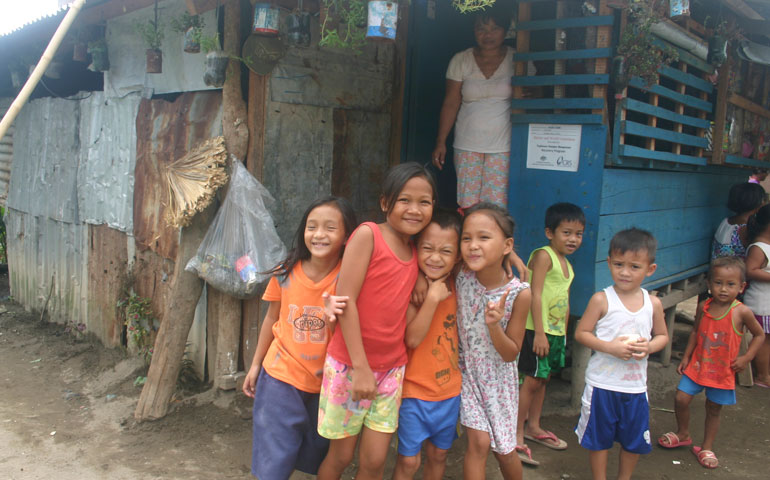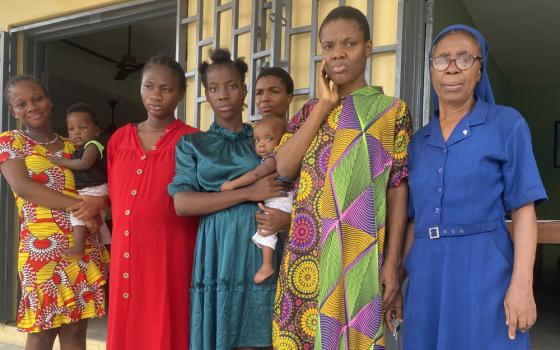
In Palo, Philippines, 68 percent of schoolchildren are infected with schistosomiasis. In this neighborhood, almost every adult has tested positive for the parasite, which is spread through skin contact with contaminated water. (Photos by Joanna Gardner)
Human waste disposal is a taboo subject. People don't like to talk about it. People who aren't Anna Hrybyk, that is. Hrybyk has a passion for it.
During a career that has taken her to the recovery phases of the 2004 Asian tsunami, Hurricane Katrina in 2005, and Typhoon Haiyan in 2013, Hrybyk has witnessed the critical role waste plays in disaster recovery, and she doesn't have time for euphemisms. A visit to Palo, a Philippine town devastated by Haiyan and where Hrybyk is coordinator of Catholic Relief Services' Typhoon Haiyan recovery program, explains why.
The municipality on the coast of Leyte Island fell squarely in the path of Haiyan as it barreled in from the North Pacific Ocean to make landfall on the Philippines' eastern seaboard in November 2013. One person for every 48 in the town died.
Schistosomiasis, a chronic illness caused by a freshwater parasite, was already endemic in Palo; 68 percent of schoolchildren are infected. The disease is spread through water contaminated by human feces, and the parasite enters through the skin, so polluted water is not only unsuitable for drinking, but also for bathing and washing.
Improper sanitation has contributed to the epidemic. Many impoverished residents, lacking access to toilets or latrines, simply dig a hole behind their houses to serve as a bathroom or they dispose of waste in thrown-away plastic bags.
These practices are known as "open defecation," defined basically as defecation that takes place anywhere other than a toilet.
As a coastal town, Palo's water table is also extremely high, making the groundwater susceptible to contamination. Many traditional, open-bottom septic tanks would only exacerbate the problem by further contaminating the groundwater.
When helping residents recover after the typhoon, it wasn't going to be enough for Catholic Relief Services simply to build new houses and maintain the status quo of sanitation.
This is where Hrybyk's genius comes in. During her work for CRS's response to the 2004 tsunami in India, in an area facing similar challenges, she and her team designed a septic tank called an anaerobic baffled reactor.
As the name implies, the system is complex, but in a nutshell, the tank, made from fiber-reinforced plastic that will not crack or seep, features a sealed bottom that collects sludge while multiple "baffled" chambers filter water into the ground. Because it's large enough to be shared among multiple households, the system, while more expensive than a single household septic tank, actually cuts costs.
The tanks themselves were only part of the solution in Palo. Hrybyk's team had to conduct a series of environmental studies in order to cluster households around a shared tank based on their location and environmental conditions like soil type and water table level.
"We had to do a lot of hydrogeology studies ourselves," Hrybyk said. "There's not enough information here about what goes on beneath the surface."
The team worked with landlords to approve the clusters, sometimes with tenants from multiple landlords sharing one tank.
Then the tanks had to be built and installed, along with individual latrines for each household. CRS trained community leaders and carried out hygiene and sanitation education. Roughly half of Palo's neighborhoods have been declared "zero open defecation communities" since CRS's work began.
Ten thousand households in Palo are targeted for sanitation assistance over the course of CRS's five-year recovery program. More than half of those households so far have completed latrines.
A closed-bottom septic tank eventually fills and needs to be emptied -- for these tanks, in roughly two years. The town had no such capacity, so CRS built its own infrastructure and has been managing de-sludging and treatment on its own.
The goal is to pass on those facilities to local government. CRS has a strong relationship with Palo Mayor Remedios Petilla*, who is a major supporter of the project. But Petilla needs public support for a city ordinance to provide additional tax revenue to take on the sewage collection and treatment process.
So CRS has one final task: launch a public information campaign convincing the people of Palo that a 30-peso (roughly 60-cent) hike in their monthly water bill to pay for the costs of collecting sludge is worth it. The campaign aims to educate residents about the connection between schistosomiasis, which affects everyone in the town in some way, and sanitation.
The campaign kicked off in November during a town festival. The mayor put her arts committee to the task of designing costumes for mascots that would march in the parade: a freshwater snail (the animal that serves as an intermediary host for the schistosomiasis parasite), a fly, and, yes, a blob of poop.
Petilla knows it is only a matter of time before the next disaster and she wants her community to be educated and prepared.
"I maybe give it two years, three years, there will be another disaster," Petilla said. "So I treat [sanitation] like a disaster. This should be done now before it comes."
[Joanna Gardner is a 2015 Egan Journalism Fellow with Catholic Relief Services, which sponsored her trip to the Philippines. She works in communications for Catholic Charities, and writes for the Catholic Star Herald, diocesan newspaper of Camden, N.J.]
*The mayor's name was misspelled in an earlier version of this story.


